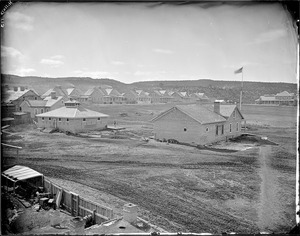Fort Wingate - Wikipedia
| Fort Wingate is near Gallup, New Mexico. There were two
locations in New Mexico that had this name. The first one was located near
San Rafael. The new location called Ft. Wingate was established on the
southern edge of the Navajo territory in 1868. The initial purpose of the
fort was to control the large Navajo tribe to its north. It was involved
with the Navajo's Long Walk. From 1870 onward the garrison was concerned
with Apaches to the south and hundreds of Navajo Scouts were enlisted at
the fort through 1890.
History
1860 A temporary post, Fort Fauntleroy,
was established at Bear Springs
(Ojo del Oso), a place visited by
Navajos. Later it was renamed Fort Lyon, when
General Thomas T. Fauntleroy, for
whom the fort was originally named, joined the
Confederates.
1862 The post was renamed Fort Wingate
after the abandonment of an army post of
that name located sixty miles away
in San Rafael, New Mexico, also known as
|
 Fort
Wingate in the 1870s Fort
Wingate in the 1870s |
"Bikyaya" or "El Gallo," and which was originally
located at Seboyeta. It was
named for Major Benjamin Wingate,
5th U.S. Infantry, who received wounds to his
legs during the Battle of Valverde.
September General Edward Canby
ordered a new fort to be placed at the headwaters of the Gallo River. It
was designed to house four
companies of troops.
1864 Colonel Kit Carson was ordered
by Canby to bring four companies of the First New Mexico Volunteers to
the fort to control the Navajo.
1865 there were 3,089 troops
in the New Mexico Military District, 135 at Fort Wingate. It was the staging
point for Navajos being sent on the
Long Walk
1873 - 1886 Participated in Apache
Wars with troops and recruited Navajo Scouts.
1878 there were 137 troops at Fort
Wingate.
Was asked to settle disagreements between
Navajo and citizens in New Mexico
1868-1895.
1891 Assisted Arizona units with angry
Hopis
1907 Two troops of the 5th Cavalry
went from Fort Wingate to the Four Corners area after some armed Navajo.
This was the last armed
expedition the US Government ever
made against the Navajo. One Navajo was killed and the rest escaped
1911 A company of cavalry went from
Ft. Wingate to Chaco Canyon and camped there several days to quell a possible
uprising by Navajo
1914 Over 2,000 Mexican soldiers and
their families were given refuge at the fort from the Mexican Civil War
1918 Fort Wingate focus turned from
Navajo to World War I .
1940 Used to store munitions from World
War II onward.
1950 Bureau of Indian Affairs given
part of the land for Indian boarding school
Redstone and the Pershing 1 missiles
were tested among other things at Wingate
1993 the Base Realignment and Closure
Act (BRAC) closes the post. Environmental cleanup and land transfer to
the surrounding community
continues to the present day.
Famous military figures
Several famous military commanders cycled through Fort
Wingate's history.
Lt. Charles B. Gatewood (later convinced
Gerinimo to surrender) led many patrols out of Wingate
1881-85 General Douglas MacArthur lived
at the fort as an infant, with his father who was a Captain in command
of
Company K, 13th US Infantry.
1889-90 General John J. (Black Jack)
Pershing served as Lieutenant at the fort.
The above extracted from (AMCIS-102 dated 1 July 1970
Ft Wingate)
|